

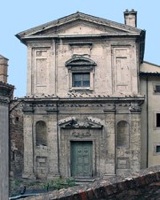
The Canons of the Holy Sepulcher built a church and hospice here in 1184 in order to help pilgrims setting out for the Holy Land.
Canons of the Holy Sepulcher
Tradition has it that Godfrey of Bouillon, the first Christian King of Jerusalem, established this order in ca. 1099 as an "honour guard" for the Holy Sepulcher. Whatever the precise truth of this claim, it is clear that the order was formed in Jerusalem at about this time and that it soon established itself across Europe. Unlike the broadly contemporary Knights Templar and Knights Hospitaller (Order of St John of Jerusalem), the Order of the Holy Sepulcher was not a military order.
Following the fall of Jerusalem in 1187, Order of the Holy Sepulcher became fragmented. The superior of the convent at Perugia took the title of "Master of the Holy Sepulcher”, a claim that gained acceptance in Italy, but not elsewhere. In 1291, the church of San Luca and adjacent Casa della Commenda became the headquarters of the Order. The earlier church and hospice of Santa Croce was presumably dependent upon it from at least this time.
In 1307, after the suppression of the Templars, the Canons acquired the complex of San Manno. This was used as the residence of the Master until 1356, when the complex was transferred to the Order of the Hospital of St John.
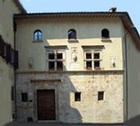
The church of Santa Maria dei Francolini was documented as a possession of San Luca in 1482.
Order of the Hospital of St John
In 1489, in the Bull “Cum solerti meditatione pensamus”, Pope Innocent VIII subordinated the Canons of the Holy Sepulcher to the Order of the Hospital of St John of Jerusalem. The title of "Master of the Holy Sepulcher” and all the property of the Canons in Italy (including San Luca) passed to the Grand Master of the Hospitallers on Rhodes, and the Perugia "Master" was granted a high rank within this Order. (In the event, the bull proved to be impossible to enforce outside Italy).
In 1512, the Knights of St John donated a site next to San Luca to the Commune for a new church, Santa Maria della Luce, which was to be built to house a highly venerated image of the Virgin. This necessitated the construction of a new facade on what had originally been the right wall of the church (see below).
The Knights of St John became known as the Knights of Malta in 1530, when they established their base on the island. The transfer of San Luca to this order was confirmed in 1560.
The Casa della Commenda was converted to use as a wool factory in the 18th century and subsequently adapted for residential use. The complex now houses the Gallerie dei Gerosolimitani (4-8 Via San Francesco) and is used for cultural exhibitions.
Exterior of the Church
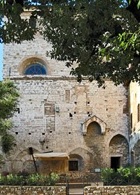
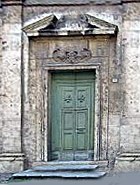
A SIXTO REGITUR ROMANA ECCLESIA QUINTO MILITIAE ET RHODIAE PRAESIDET UGO LUBENX VERONA SATUS HANC SUMPTU CUM JULIUS AEDEM EXORNAVIT BRAVIUS RESTITUISQUE SUO M D LXXXVI
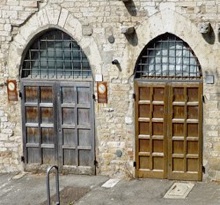
The cross of the Knights of Malta can be seen on the keystone of one of the two portals to the left of the old facade.
Interior
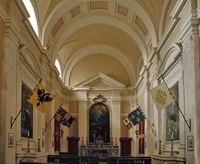
The present church is usually closed. Its rectangular interior is split into three bays by pairs of pilasters on each side wall.
Madonna and Child with saints (1632)
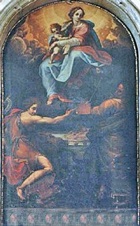
Madonna delle Grazie (15th century)
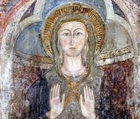
Crypt
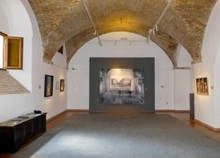
The old church, which served as the crypt of its successor, now houses part of the Gallerie dei Gerosolimitani.
Read more:
The material on the history of the Canons of the Holy Sepulcher is taken from the website of Guy Stair Sainty.
O. Gurrieri, “La Chiesa di San Luca Evangelista del Sovrano Militare Ordine di Malta” (1973) is published on the internet.
Return to Monuments of Perugia.
Return to Walk III.

